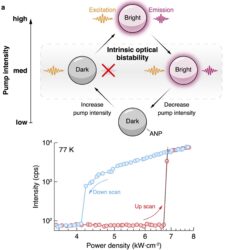Scientific Achievement

Demonstration of intrinsic optical bistability (IOB) in avalanching nanoparticles. The nanoparticles exhibit optical memory and high contrast switching between luminescent and non-luminescent states.
Significance and Impact
This is the 1st practical demonstration of IOB in nanoscale materials. It paves the way for nanoscale optical memory and transistors comparable to current microelectronics, offering a path to smaller, faster components.
Research Details
- •The researchers synthesized 30-nanometer nanoparticles of potassium lead chloride doped with neodymium.
- •The team identified an all-optical mechanism in which IOB originates from suppressed non-radiative relaxation in Nd3+ ions and from the positive feedback of photon avalanching, resulting in extreme, >200th-order optical nonlinearities.
Skripka, A., Zhang, Z., Qi, X. Ursprung, B., Ercius, P., Cohen, B.E., Schuck, P.J. Jaque, D., Chan, E.M. Nature Photonics 19, 212–218 (2025). DOI: 10.1038/s41566-024-01577-x
See the related press release
Research Summary
A research team of Foundry staff and users has developed a new optical computing material from photon avalanching nanoparticles. The breakthrough paves the way for fabricating optical memory and transistors on a nanometer size scale comparable to current microelectronics. This approach offers a path toward realizing smaller, faster components for next-generation computers by taking advantage of an optical phenomenon called “intrinsic optical bistability.”
For decades, researchers have sought ways to make a computer that uses light instead of electricity. Materials with intrinsic optical bistability (IOB) – a property that allows a material to use light to switch between two different states, such as glowing brightly or not at all – could serve as components for optical computers. But in previous studies, optical bistability had almost exclusively been observed in bulk materials that were too big for a microchip and challenging to mass produce. And in the few earlier reports of nanoscale IOB, the process was not well understood and was assumed to occur by heating the nanoparticles, which is inefficient and difficult to control.
This recent study suggests that the new photon avalanching nanoparticles could overcome these challenges in realizing IOB at the nanoscale. The new nanoparticles exhibit the highest nonlinearities that anyone has ever observed in a material and also continue to emit brightly even when the laser power is reduced below that threshold. They only turn off completely at very low laser powers. The large difference between these “on” and “off” threshold powers means that there are intermediate laser powers at which the nanoparticles can be either bright or dark and the ability to switch optical properties without changing the material suggests that the nanoparticles may serve as nanoscale optical memory, particularly volatile random-access memory (RAM).

